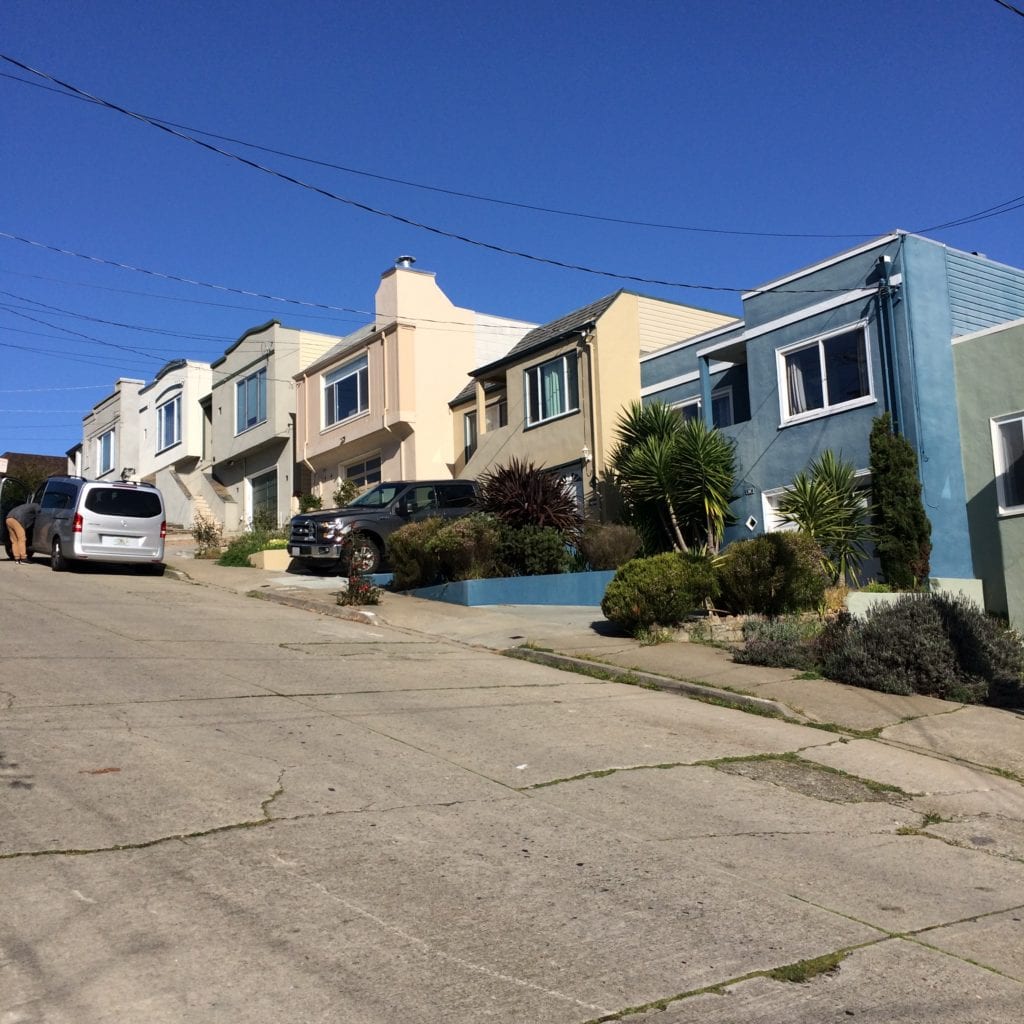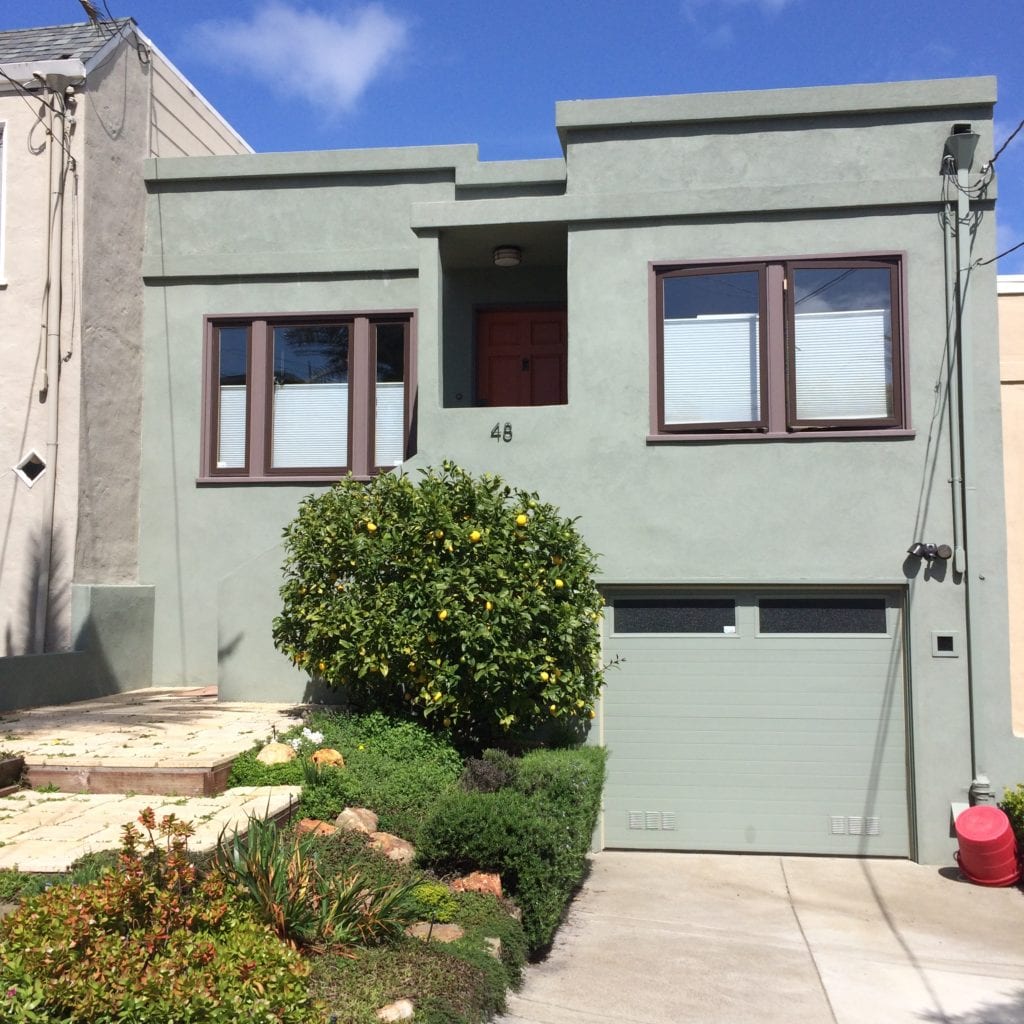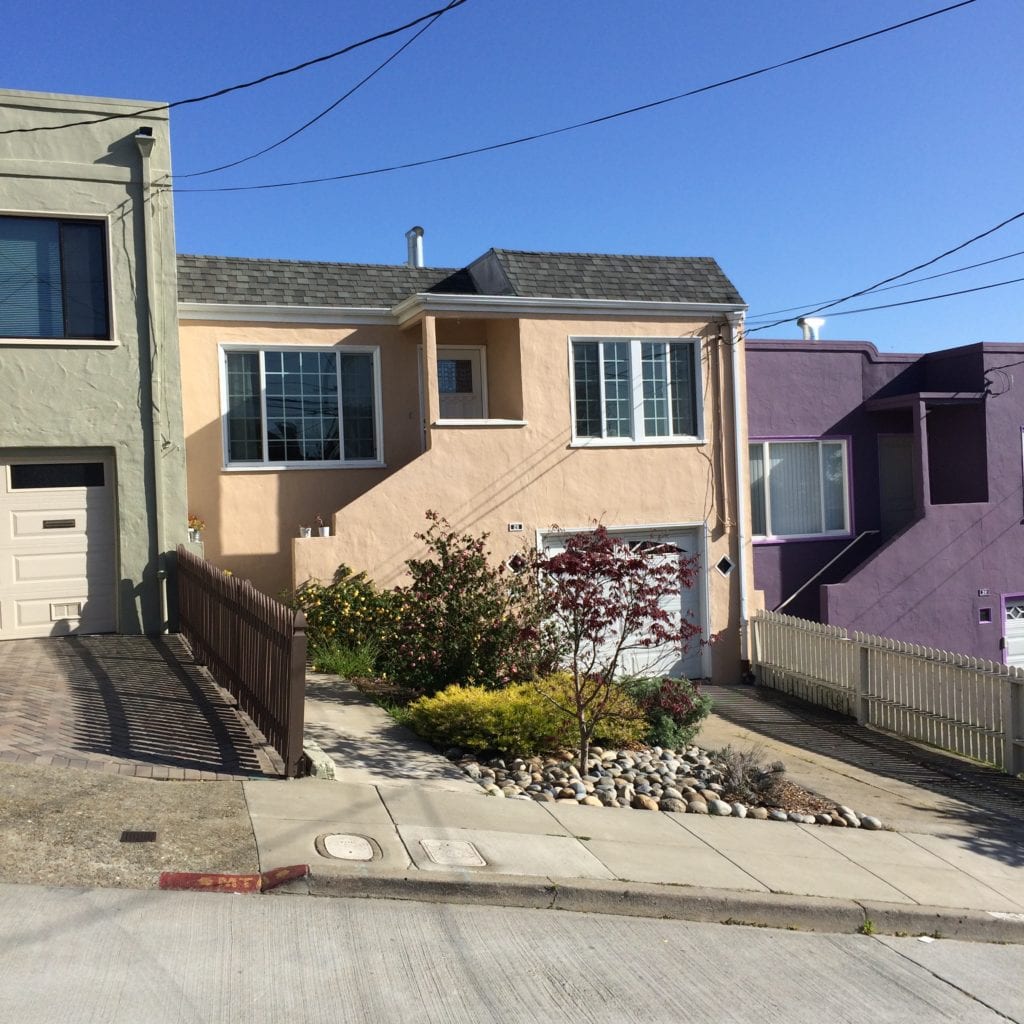
Essay and photos by Jemison Beshears
One of the joys of walking through the streets of Glen Park is seeing all the houses in their wild variety and wondering what stories they might disclose if you only had a guide to tell them. Here, Jemison Beshears, a 32-year resident of Melrose Avenue, which runs just a few short blocks in the area between Dorothy Erskine Park (known to many simply as Martha Hill) and Sunnyside parks, takes us on a tour down memory lane.
Melrose Avenue in Sunnyside was first conceived in the 1890s, part of the original 200-acre housing development built by James P. McCarthy and M.W. Conner. They were Los Angeles-based developers who saw an opportunity to expand their fortunes in San Francisco at a time when the city was growing steadily. For those who might have wondered, there truly is a connection between the famous Melrose Place in L.A. and Melrose Avenue in San Francisco, as Amy O’Hair lays out in an article on the Glen Park Neighborhoods History Project.
 We have heard many related stories since occupying our home, most have involved Mr. Behrend Joost. He was “The Grand Old Man of Twin Peaks“, an early grocer, hardware man and local entrepreneur who had much to do with the earliest history of Sunnyside, including his establishment of the Sunnyside Land Co. in April of 1891. He also founded the first electrical railway in San Francisco and was somewhat responsible for the naming of many streets in Sunnyside after rich tycoons such as Mangels Avenue and of course, his own Joost Avenue.
We have heard many related stories since occupying our home, most have involved Mr. Behrend Joost. He was “The Grand Old Man of Twin Peaks“, an early grocer, hardware man and local entrepreneur who had much to do with the earliest history of Sunnyside, including his establishment of the Sunnyside Land Co. in April of 1891. He also founded the first electrical railway in San Francisco and was somewhat responsible for the naming of many streets in Sunnyside after rich tycoons such as Mangels Avenue and of course, his own Joost Avenue.
As a local developer, Joost was quick to point out that his Sunnyside lots were “NOT in the sand dunes”. He had purchased the land from Leland Stanford, knowing that with Adolf Sutro’s lands to the west his Sunnyside development would be the creme de la creme of San Francisco subdivisions.
A walk along Melrose Avenue reveals a plethora of houses known in the trade as “Junior Fives.” Each of these houses has a living room, bath, kitchen with a dining area and two bedrooms in the back, usually with a one car-garage below. A “Full Five” had a separate dining room. Both were meant for working class families, they were small, affordable homes that while not fancy were very popular.
 Many homes on Melrose have been remodeled over the years but their basic configuration has remained. While lots on this street were sold as early as 1887, most of the houses existing today were built in the 1940s. The most common additions are exterior decks on their back side, both covered and uncovered.
Many homes on Melrose have been remodeled over the years but their basic configuration has remained. While lots on this street were sold as early as 1887, most of the houses existing today were built in the 1940s. The most common additions are exterior decks on their back side, both covered and uncovered.
Our own home, at 43 Melrose, was built in 1943 by the Tru-Value Construction Company, the principals being Sherry M. Morrell and Walter and Max Hansen. The last two were carpenters who, according to owner lore, built the current house on that plot. Finding that our house was not built by legendary Sunset and Daly City developer Henry Doelger was a bit disappointing but I was still elated that I had finally discovered the actual builders were the Hansen brothers.
Beyond our street, the neighborhood, too, has changed in the 30 plus years since we first moved in. The biggest difference was the building, in 2007, of the Canyon Market with the library on top on Diamond St. It took the place of old Safeway grocery store – or the Diamond Super as it was usually called. Next door was the Hancock (later the Associated Oil Company) service station where the Bello coffee shop now stands.
Many businesses have come and gone in our time here. Before 1970 there were lots of corner grocery stores and service stations, now almost all gone except for Buddies at the northeast corner of Chenery and Diamond. Bank branches, too, have disappeared. Glen Park once was home to both a Bank of America and a Citibank but now only ATMs for B of A and Wells Fargo remain. Restaurants, too, have risen and fallen included a pizzeria that became Chenery Park restaurant, which now stands empty.
Some things, however, haven’t changed at all. Buddies, the Glen Park Station bar, Glen Park Dry Cleaners and Tyger’s diner all are going strong. In fact one of my daughters was a waitress at Tyger’s in the late nineties,
Another thing that hasn’t changed is Leo Park, the legendary UPS driver who has been on his route in Glen Park for more than 35 years now. He is always cheerful and knows almost everyone he encounters on our street. I remember thinking Leo displays the character traits to me that all people should have.
The demographics of Melrose Avenue have changed a bit since 1987 when we first bought our house. Back then, many on the street were older retirees or middle and upper middle class professionals. In 2006, the San Francisco Chronicle described Sunnyside as one of the last chances for the middle-class home buyer. Today the tenants of Melrose have evolved to include younger middle class workers and professionals, with many younger families moving into beginner homes who will eventually move on as their families enlarge.
The original working class nature of the neighborhood is no more. It has changed, as has all of San Francisco, to be more white collar workers and professionals. Some, though, still work with their hands – though not perhaps in the mechanical sense of the original inhabitants in the 1940s.
Several years ago our block was home to two special gentleman who worked with their hands. I was at my desk in a local auction house, where I was an antique firearms specialist, when my wife Patricia called.
“You would not believe who I just hugged at the door,” she told me excitedly.
UPS driver Leo had made arrangements to drop a package for another neighbor two houses down, as the neighbor wasn’t going to be home to accept it.
With wet hair and in a bathrobe, Patricia had just hopped out of the shower when the neighbor knocked on the door to pick up his package. He turned out to be none other than than-Giants pitcher Sergio Romo. His friend and fellow pitcher Barry Zito lived across the street.
Just another day in San Francisco. In fact, I have distinct memories of Romo and the Beamers he owned and often worked on. One morning I almost ran over him as I drove out for the day.
While Melrose and environs has changed in some ways, in many others it has remained true to its roots, a solid neighborhood of San Franciscans of all types, who have given us memories we will cherish the rest of our lives.